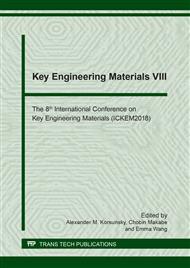[1]
A. Reti, Silver: Alloying, Properties and Applications, Encyclopedia of Materials Science & Technology 23 (2001) 8618-8621.
DOI: 10.1016/b0-08-043152-6/01536-9
Google Scholar
[2]
D. X. Li,. Precious metal material science. Central south university of technology press, Changsha,(1991).
Google Scholar
[3]
J. R. Davis, Metals handbook: desk edition, ASM International, (1998).
Google Scholar
[4]
C. J. Pu, M. Xie, W. J. Du, Research Development of Precious Metal-based Electric Contact Materials, Mater. Rev. 28(2014) 22-25.
Google Scholar
[5]
J. K. Liao, Y. H. Liang, W. W. Li, Y. C. Men, Silver alloy wire bonding, Electronic Components and Technology Conference. IEEE, 282(2012) 1163-1168.
Google Scholar
[6]
J. Tsai, A. Lan, D. S. Jiang, L. W. Wu, Ag alloy wire characteristic and benefits, Electronic Components and Technology Conference. IEEE, 2014 1533-1538.
DOI: 10.1109/ectc.2014.6897498
Google Scholar
[7]
D. E. Kim, S. L. Shang, Z. K. Liu, Effects of alloying elements on elastic properties of Ni by first-principles calculations, Comp. Mater. Sci. 47(2009) 254-260.
DOI: 10.1016/j.commatsci.2009.07.014
Google Scholar
[8]
J. Wang, Y. Du, S. L. Shang, Effects of alloying elements on elastic properties of Al by first-principles calculations, Journal of Mining & Metallurgy 50(2014) 37-44.
DOI: 10.2298/jmmb140116002w
Google Scholar
[9]
S. Ganeshan, S. L. Shang, Y. Wang, Z. K. Liu, Effect of alloying elements on the elastic properties of Mg from first-principles calculations, Acta Materialia 57(2009) 3876-3884.
DOI: 10.1016/j.actamat.2009.04.038
Google Scholar
[10]
D. E. Gray, American Institute of Physics handbook, New York: McGraw-Hill, (1972).
Google Scholar
[11]
R. Bacon, C. S. Smith, Single crystal elastic constants of silver and silver alloys, Acta Metall. 4(1956) 337-341.
DOI: 10.1016/0001-6160(56)90021-9
Google Scholar
[12]
Y. L. Page, P. Saxe, Symmetry-general least-squares extraction of elastic coefficients from ab initio total energy calculations, Phy. Rev. B, 63(2001) 145-155.
DOI: 10.1103/physrevb.63.174103
Google Scholar
[13]
R. Hill, The Elastic Behaviour of a Crystalline Aggregate, Proc.Phy. Soc. 65(1952) 349-354.
Google Scholar
[14]
W. B. Pearson, Chapter XI- An alphabetical index of work on metals and alloys, A Handbook of Lattice Spacings and Structures of Metals and Alloys, Elsevier Ltd, (1958).
DOI: 10.1016/b978-1-4832-1318-7.50015-2
Google Scholar
[15]
Lange, NorbertAdolph. Lange's handbook of chemistry /-12th ed. McGraw-Hill, (1979).
Google Scholar
[16]
Y. A. Chang, L.Himmel, Temperature Dependence of the Elastic Constants of Cu, Ag, and Au above Room Temperature, J. Appl. Phys. 37(1966) 3567-3572.
DOI: 10.1063/1.1708903
Google Scholar
[17]
S. L. Shang, A. Saengdeejing, Z. G. Mei, et al, First-principles calculations of pure elements: Equations of state and elastic stiffness constants. Comp. Mater. Sci. 48(2010) 813-826.
DOI: 10.1016/j.commatsci.2010.03.041
Google Scholar
[18]
M. Born, Thermodynamics of Crystals and Melting, J. Chem. Phys. 7(1939) 591-603.
Google Scholar
[19]
S.F. Pugh, Relations between the elastic moduli and the plastic properties of polycrystalline pure metals, Philo. Mag. 45(1954) 823-843.
DOI: 10.1080/14786440808520496
Google Scholar
[20]
W.C. Hu, Y. Liu, D. J. Li, et al. Structural, anisotropic elastic and electronic properties of Sr–Zn binary system intermetallic compounds: A first-principles study, Comp. Mater. Sci. 99(2015) 381-389.
DOI: 10.1016/j.commatsci.2014.12.034
Google Scholar


